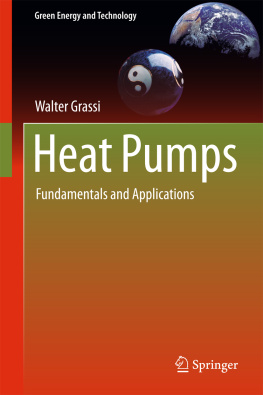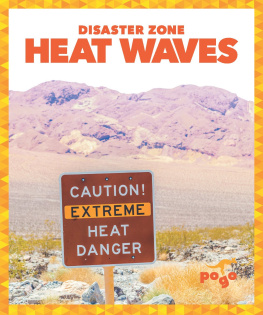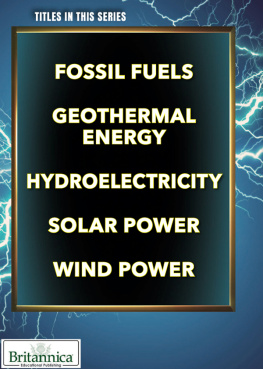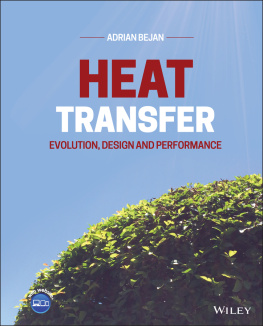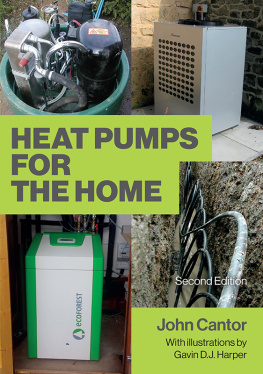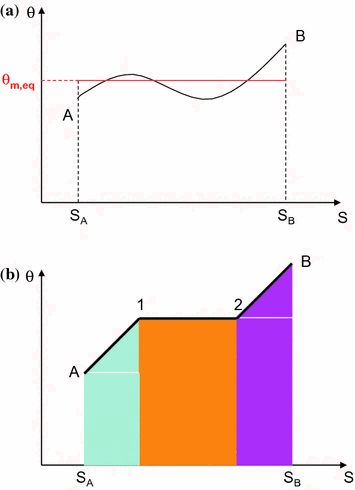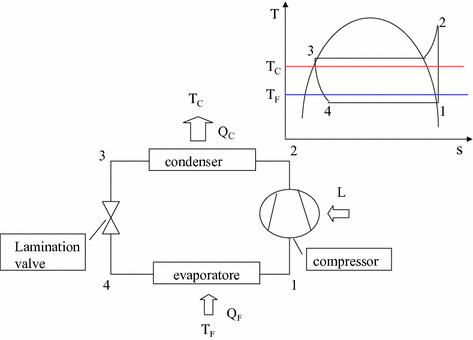1.1 General Features
Heat pumps are an effective means of energy production in several fields of modern technology. To have an idea of the present situation we can refer to []. It reports a European market increase of 3.5% in 2014 with respect to 2013. Even if some countries recorded a decrease of the sold units, it was largely compensated by the top 10 markets led by France, Spain and Finland. In particular France (leading country) followed by Italy and Sweden reached more than hundred thousand units sold per year, while Finland, Germany, Norway and Spain exceeded fifty thousand of annual sold units.
A fast increase of using heat pumps for sanitary water production is taking place both as stand alone units (heat pump and water storage tank in the same casing) or as heat pumps with separate tanks.
Air has been and is the most diffused heat source so far, while larger heat pumps are increasingly employed for industrial and commercial uses, and for district heating. Air is still used, but also geothermal and hydrothermal sources are often employed. In some cases heat is provided by waste waters. To have a short insight on the more general state of the art in the world we can refer to [].
It reports an increase of the world heat pump market of 7.2% by volume in 2013 with about two million units, jointly due to a recovery in Europe and to a strong increase of heat pump heaters in the USA. In terms of value in 2013 there was a decrease of 6.5% with respect to 2012, mainly due to an increasing competition among providers and a sale decrease of large power units. In 2013 heat pump heaters had a large diffusion with a market growth of 26.5%. Anyway this growth mainly occurred outside Europe, where airwater heat pumps and split systems dominated the market with small capacity machines, at the expenses of monobloc systems (sale decreased by 2%). Just the opposite occurred in China where these latters sales grew by around 14% and the worldwide increase is about 5%. Geothermal heat pumps performed poorly in 2013. High initial investment costs and lack of appropriate political support act as the major drawbacks. Despite of this they recorded a 5% increase in China and in the USA, while decreased by 1% in Europe. On the other hand, exhaust air heat pumps with heat recovery for energy saving in buildings are an emerging technology, in particular in Scandinavia, and is expected to expand at least in Northern Europe. Furthermore it is the case to stress how CO2 heat pumps had a significant rise in commercial and residential applications due to their environmental friendly features.
At present, the major segments of market [] also pinpoints some of the major global market players in: Viessmann Group, Danfoss Group Global, Carrier Corporation, the Glen Dimplex Group, StiebelEltron, Bosch Thermotechnik GmbH, Panasonic Corporation, Mitsubishi Electric, NIBE energy systems, Geothermal International Ltd (GI), DeLonghi-Climaveneta, Airwell Group, and Enertech Group.
Heat Pumps are classified according to several characteristic features. A first one consists in the type of their thermodynamic cycle and therefore in nature of fluids they use. On the basis of this we talk about vapor compression and absorption heat pumps. The former follow a traditional inverse thermodynamic cycle and use a compressor driven either by an electric motor or an engine. The used refrigerants have to be (at least should be) environment friendly, inert, chemically stable, neither flammable nor toxic, with low freezing temperatures and compatible with lubricating oils.
Absorption heat pumps do not have a mechanical compressor. They use a mixture of two fluids with a different vapor pressure. The more volatile one evaporates and, then, recombines with the less volatile. The most common mixtures are water and lithium-bromide and water and ammonia.
We can further differentiate heat pumps according to the type of source they heat exchangers interact with. The final fluid to be heated or cooled is the indoor air in most of the residential uses. The fluid flowing in heating, or cooling, devices can be the refrigerant itself (generally in case of short circuits) and we speak of direct expansion systems. Otherwise water is used to this aim, exchanging heat with the refrigerant in the heat pump heat exchangers.
The most common outdoor heat source is air, but also surface water (rivers, lakes and sea), ground water and even the ground itself.
Lastly heat pumps can be used for sanitary water production only or to both heating and sanitary water production. Often they are used in combination with a backup device (boiler for winter heating). In this case we speak of hybrid systems.
1.2 Working Principles
First of all let us define a physical quantity useful to easily identify the thermodynamic performances of any thermodynamic cycle: the equivalent heat exchange average temperature, Tm,eq (K). Consider any transformation taking a system from point A to point B, as in Fig. a. The above temperature is equal to the ratio between the exchanged heat (subtended area by curve AB) and the entropy difference between B and A:
Doing so, it is possible to reduce a transformation to an isotherm where the actual heat exchange takes place. If now we refer to Fig.
Fig. 1.1
On top the equivalent heat exchange average temperature. At the bottom the contributions to this temperature of different segment of a transformation
In the simplest configuration for residential uses a heat pump consists of an outdoor unit, containing compressor and a heat exchanger working as an evaporator in winter and a condenser in summer, and an indoor unit with another heat exchanger complementary to the previous one (condenser in winter and evaporator in summer). If subscripts C and F respectively indicate the hot and cold sources, the following relations hold (Figs. :
Q is the heat exchanged with thermal sources, T their thermodynamic temperature (K) and Sg the amount of produced entropy. This is due to existing irreversibilities both internal (e.g., friction losses in fluid motion, in mechanical devices etc.) and external, as the temperature jump between evolving fluid and thermal sources.

